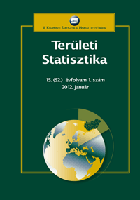A fiatal, képzett lakosságot vonzó potenciál a Budapest körüli csapágyvárosokban
Potential for attracting young and educated people in the outer city ring around Budapest
Author(s): Virág Varga, Dorottya Teveli-Horváth, Géza SalaminSubject(s): Social Sciences, Economy, Geography, Regional studies
Published by: Központi Statisztikai Hivatal
Keywords: polycentric development; human capital; creative class; creative city; population retention potential; talent attraction
Summary/Abstract: The role of cities and urban regions in the global economy is growing in tandem with globalization trends. With the rise of the knowledge economy, the ratio of young and well-educated people can be an indicator of the success of a settlement, as they make up the social group that is the most mobile and the most able to change their place of residence and work. Urban competitiveness and socio-economic sustainability are fundamentally determined by the number of available young and well-educated people, so keeping and attracting this group is a priority for cities. In Hungary, the medium-sized and large towns of the country are mainly confronted with the attraction of Budapest and foreign cities. In order to solve the monocentric (‘primate city’ dominated) settlement structure of our country, a development concept was worked out for the outer city ring around Budapest (Dunaújváros, Gyöngyös, Kecskemét, Salgótarján, Székesfehérvár, Szolnok, Tatabánya). In their research, the authors compare the population attractiveness of these cities (with particular reference to the young, educated population) applying a complex index developed by them based on official statistics and Big Data like sources. A complex index of 70 indicators (creative knowledge attractiveness index) is used to rank these cities in terms of their potential to retain and attract creative people and how this potential changes. According to their results, Kecskemét is ranked first, Székesfehérvár ranked second and Szolnok ranked third.
Journal: Területi Statisztika
- Issue Year: 60/2020
- Issue No: 02
- Page Range: 179-210
- Page Count: 32
- Language: Hungarian

